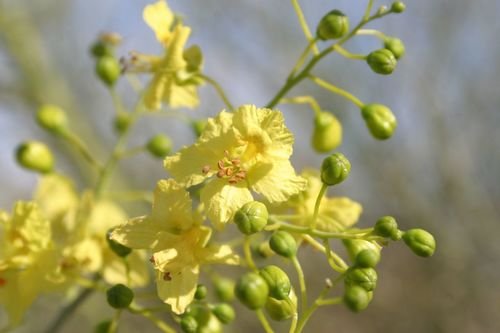Blue Palo Verde
Parkinsonia florida
Family: Fabaceae
OTHER NAMES
O’odham: Koˊokmaḍ
CHARACTERISTICS
Medium, moderately thorny deciduous tree (photosynthetic trunk) to 30’ or more tall and wide. Plants bloom March to May and occasionally again from August to October following summer monsoon rain and are followed by legume seed pods. Though many people claim to be allergic to this plant, the pollen is larger and sticky, which doesn’t lend to being wind-borne (native bees are the primary pollinators of this species, not the wind). But as with many species that are prominent and yellow, they get blamed for allergies (they bloom at the same time many wind-pollinated plants are blooming). That isn’t to say that one can’t be allergic to the pollen (people are allergic to all sorts of pollen, wind-borne or not), but when one is suffering, the likely candidates for allergies are probably not this plant.
Photo of Parkinsonia florida by Stan Shebs on Wikipedia
Parkinsonia florida on SEINET
Parkinsonia florida on iNaturalist
LANDSCAPE USE
One of the best, fast-growing shade trees of our region.
GROWING CONDITIONS
AN EXPLANATION OF TERMS USED
SUN full sun
WATER moderate to low water (faster growing with more water), can live on rainfall when established
SOIL not picky, but well-drained
HARDINESS hardy to 10°F
BASIN middle zone
CONTAINER tolerates containers
NUTRITION low
MAINTENANCE very little
ECOLOGY
Flowers provide nectar for bees, butterflies, important nesting plant for birds, seeds attractive to granivorous birds, several moth and beetle species depend on this species as adults and larvae, the mistletoe important to phainopepla birds and is also a larval host for the great purple hairstreak (Atlides halesus). Because this tree typically grows along washes there is likely to be deep sandy soil nearby for the digger bees (there are many species). These bees create long tubular nests in the sand with pollen and nectar gathered from palo verdes. Flushing its new foliage in late May, the tender shoots of blue palo verde are attractive to adult leaf beetles of the genera Cryptocephalus and Saxinus. This is a larval host for the Forsebia Moth (Forsebia cinis), Juno Buckmoth (Hemileuca juno), Royal Poinciana Graphic (Melipotis acontioides), and the Black-tipped Rudenia Moth (Rudenia leguminana).
Palo verdes are the favorite host for the larvae (grub worm) of the palo verde beetle (Derobrachus hovorei). Though they are blamed for the demise of palo verdes, these beetles mostly eat dead wood and these species have evolved together for thousands of years. Desert mistletoe is also hosted on palo verdes and gets blamed for killing them. Usually, the real demise of blue palo verdes is the dropping water table caused by humans.
ETHNOBOTANY
This tree provides edible flowers and pods for humans.
NATURAL DISTRIBUTION
Generally found along washes, plains, and canyons, sometimes on slopes from sea level to 4,000 ft. in southern and western Arizona, southeastern California, down into Sonora and Baja California.
TAXONOMY AND NAME
This plant is in the Fabaceae, the legume family. There are 9 species of Parkinsonia native to semi-desert regions of Africa and the Americas.
Parkinsonia is named after John Parkinson (1567-1650), florida refers to the free-flowering, abundant flowers.
Formerly known as Cercidium floridum.

Flower detail photo by Joe Decruyenaere, iNaturalist

The young, green seeds can be eaten like edamame. Photo by Cactus Kelly, iNaturalist

A ripe seed pod, photo by Steve Jones, iNaturalist

The trunk of blue palo verde does not keep a green trunk like the foothill palo verde or the palo brea. Photo by Steve Jones, iNaturalist

